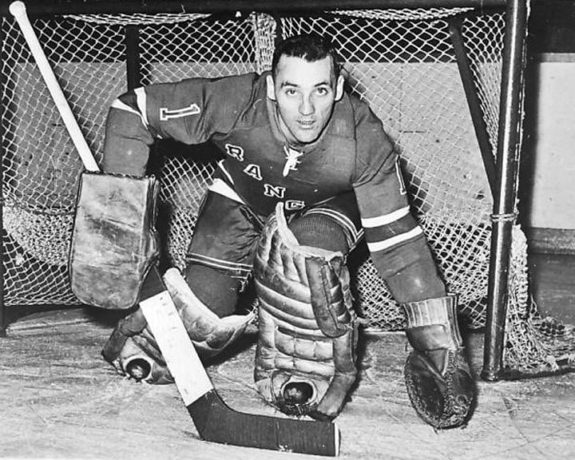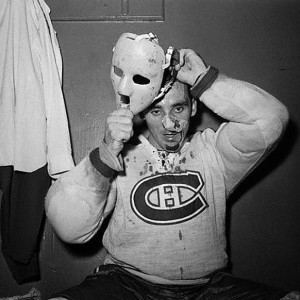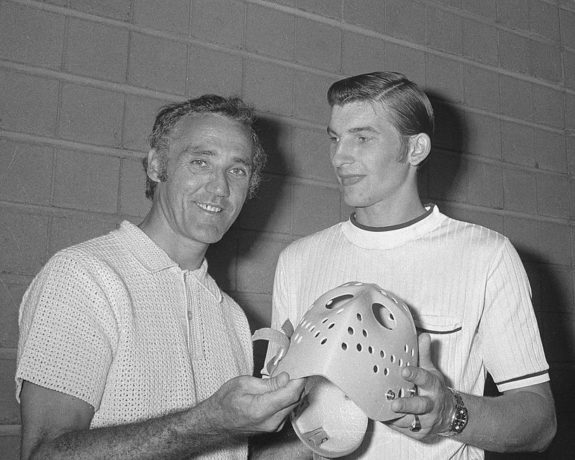The month of November is perhaps the most important for any present-day goaltender guarding the crease in the National Hockey League – but most might not even know why. It was during that month back in 1959 that the position changed forever, thanks to a 6-foot, 175-pound man from Quebec.
Advancement in Goalie Gear Was Slow in Coming
It had been nearly 42 years since the formation of the NHL and advancements in player equipment had been progressing at a slow pace, especially the position of goaltender which seemed to be the most prehistoric. One can only imagine how difficult being a goaltender was in hockey’s earliest days, with little to no protection, simply using your body as a shield in front of the net.

As time went on, equipment became part of the goaltender’s repertoire. The protection first began with equipment being applied below the waist. Leg pads were added in 1896, after George Merritt of the Winnipeg Victorias strapped a pair of cricket pads to his legs in order to protect his kneecaps during the Stanley Cup challenge. After the turn of the century, players began to wear leather or canvas gloves to cover their hands – even the goaltenders. Several modifications were made to the equipment throughout the years in the hopes of less risk of injury but it wasn’t until November 1, 1959 that the goaltender mask was introduced to the NHL – or was it?
Though that is the date when Jacques Plante innovated the position of goaltender in the NHL by popularizing equipment for the face, he’s not actually the first goalie who wore a mask in the NHL – despite what we are lead to believe.
No, that honor goes to a player by the name of Clint Benedict. The Montreal Maroons goaltender became the first in the NHL to wear a face cover on February 20, 1930 after a shot from Howie Morenz broke his nose. The leather facemask proved impractical for Benedict and after just two games he abandoned it and reverted back to his maskless self.
Okay, so Plante wasn’t the first; he was the trendsetter, however. There’s a reason he’s the father of the goaltender mask and it has as much to do with his style of play as it does with his persistence.
Plante, a Quebec native, began to play hockey at the age of four – with a tennis ball for a puck, no skates and a goaltender’s hockey stick his father carved from a tree root. As he grew up, Plante excelled at the position of goaltender and by the age of 18 he joined a juniors team called the Quebec Citadelles, at which point it was clear that he would innovate the game in one form or another. Plante began to play the puck outside of the crease, developing the technique after noticing that his team’s defense was performing poorly. Fans found the new style exciting but Plante only did it with the idea that as long as he controlled the puck, his opponents wouldn’t be able to shoot at him.
Montreal Canadiens Come Calling for Jacques Plante
Almost six years later, Plante got the call-up to play for the Montreal Canadiens and just months later he – and the rest of the Canadiens – were immortalized with their names engraved on the Stanley Cup, though he was the second option to goaltender Gerry McNeil. But six years later, Plante wouldn’t just become immortalized – he’d become a legend.

During the 1959-60 season, the Canadiens were in the midst of winning five consecutive Stanley Cups and building perhaps the greatest dynasty the sport had ever seen. But things didn’t look good for the Canadiens and their goaltender one evening on the first of November. Just three minutes into a game against the New York Rangers, Plante was injured when a puck off the stick of Andy Bathgate shot up and hit him in the face, breaking his nose. He was escorted to the dressing room for stitches but soon returned wearing a homemade goaltender mask – which he refused to return without. Plante had worn the mask in practice since 1956 after he missed 13 games due to sinusitis but wasn’t allowed to wear it during games.

Canadiens head coach Toe Blake was unhappy about the mask but because the team had no other option at goaltender, he allowed Plante to return if he promised to discard the mask after his face healed. Montreal held on to beat the Rangers 3-1 and so the mask was born.
Call it superstition or just plain stubbornness, but Plante continued to wear the mask – even after his face healed – and the Canadiens continued to win. As the wins began to mount, Blake remained quiet about discarding the equipment but after the team’s unbeaten streak ended at 18 games, Plante adhered to Blake’s request and wore nothing on his face. Montreal lost to Detroit 3-0 that night and afterward, the mask returned – this time for good.
When I first put on the mask, the boys all told me I would scare the women. They wouldn’t come to see the games anymore. I’ll tell you something, if I went on the way I was going, pretty soon my face would look worse than the mask.
Jacques Plante’s Bravery Was Questioned
When Plante introduced the mask to the rest of the NHL some questioned his dedication and bravery but he just likened it to skydiving without a parachute. He was often laughed at and made fun of, though it wasn’t long before the rest of the league’s goaltenders were following in his footsteps. Within just a few seasons nearly every goaltender wore one. The masks, in the beginning, started out compiled mostly of fiberglass – much the way Plante had created his – but quickly evolved as popularity grew.

In the 1970s, a helmet and cage combination became popular. Within a few years, that style became the standard around the league, since it was constructed entirely of fiberglass and added adequate facial protection – unlike earlier masks which had holes. The last goaltender to play without protection was Andy Brown of the Pittsburgh Penguins, who played his final game in 1974.
Related: The 10 Coolest Old School NHL Goalie Masks
It marked the end of an era.
The Hockey Hall of Fame Welcomed Jacques Plante
Jacques Plante retired from hockey in 1975 and was honored with a Hall of Fame induction just three years later. After his career, he was able to watch the evolution of the equipment he boldly made popular – until his life was cut suddenly short in 1986, at the age of 57. He never got to see just how much more advanced the goaltender mask became and how it not only became an NHL fashion statement but how the style leaked over to the catcher’s position in Major League baseball.
You may also like:
- Prime Video to Carry National Monday Night Games in Canada
- Canadiens Need Gallagher to Play Diminished but Critical Role
- Montreal Canadiens 2023-24 Season Grades: Defense and Goaltending
- NHL Rumors: Ducks, Maple Leafs, Blues, Canadiens
- Guy Lafleur Gave Me a Lifetime of Memories
There’s no question Plante’s illustrious career is overshadowed by what he did that November night at Madison Square Garden and how, over the years, many have forgotten the road he paved for players like Patrick Roy and Martin Brodeur with his innovative stick-handling skills and his ability to cut down angles. But while those are important contributions, the mask will forever symbolize just how truly important Plante was to the game. We can only imagine that he wouldn’t have wanted it any other way.
